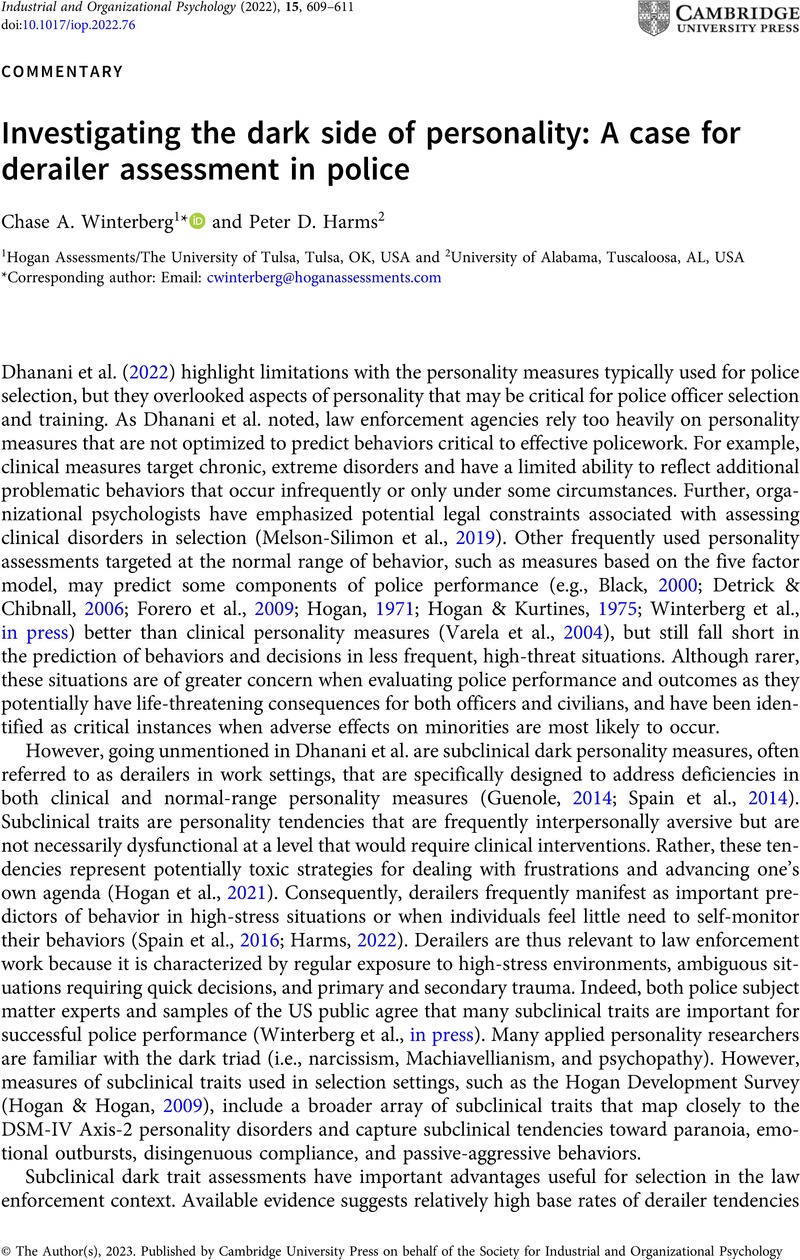No CrossRef data available.
Article contents
Investigating the dark side of personality: A case for derailer assessment in police
Published online by Cambridge University Press: 27 January 2023
Abstract
An abstract is not available for this content so a preview has been provided. Please use the Get access link above for information on how to access this content.

- Type
- Commentaries
- Information
- Copyright
- © The Author(s), 2023. Published by Cambridge University Press on behalf of the Society for Industrial and Organizational Psychology
References
Black, J. (2000) Personality testing and police selection: Utility of the “Big Five.” New Zealand Journal of Psychology, 29, 2–9.Google Scholar
Detrick, P., & Chibnall, J. T. (2006) NEO PI-R personality characteristics of high-performing entry-level police officers. Psychological Services, 3, 274–285.CrossRefGoogle Scholar
Dhanani, L. Y., Wiese, C. W., Brooks, L., & Beckles, K. (2022) Reckoning with racialized police violence: The role of I-O psychology. Industrial and Organizational Psychology: Perspectives on Science and Practice, 15
(4), 554–577.CrossRefGoogle Scholar
Ellen, B. P., Alexander, K., Mackey, J., McAllister, C., & Carson, J. (2021) Portrait of a workplace deviant: A clearer picture of the Big Five and Dark Triad as predictors of workplace deviance. Journal of Applied Psychology, 106, 1950–1961.CrossRefGoogle ScholarPubMed
Forero, C. G., Gallardo-Pujol, D., Maydeu-Olivares, A., & Andres-Pueyo, A. (2009) A longitudinal model for predicting performance of police officers using personality and behavioral data. Criminal Justice and Behavior, 36, 591–606.CrossRefGoogle Scholar
Guenole, N. (2014) Maladaptive personality at work: Exploring the darkness. Industrial and Organizational Psychology, 7, 85–97.CrossRefGoogle Scholar
Harmata, R., & Sherman, R. (2021, April) One bad apple ruins the bunch: A critical examination of “dark” personality and job performance among police officers. In R. Harmata & R. Sherman (Chairs), Good cop/bad cop: A deep dive into police officer personality. Symposium presented at the 36th Annual Conference of the Society for Industrial and Organizational Psychology, New Orleans, LA.Google Scholar
Harms, P. D. (2022) Bad is stronger than good: A review of the models and measures of dark personality. Zeitschrift für Psychologie. https://doi.org/10.1027/2151-2604/a000496.CrossRefGoogle Scholar
Harms, P. D., Spain, S. M., & Hannah, S. T. (2011) You underestimate the power of the dark side. Presented at the 26th Annual Conference of the Society for Industrial and Organizational Psychology Society for Industrial and Organizational Psychology, Chicago, IL.Google Scholar
Hogan Assessment Systems. (2021) Gender differences on the HPI, HDS, and MVPI. https://hoganassessments.netx.net/portals/hogan-hub/#share/request/4985ac56-fbd0-4095-818d-f29295e4ff9d
Google Scholar
Hogan, R. (1971) Personality characteristics of highly rated policemen. Personnel Psychology, 24, 679–686.CrossRefGoogle Scholar
Hogan, R., & Kurtines, W. (1975) Personological correlates of police effectiveness. Journal of Psychology, 91, 289–295.CrossRefGoogle Scholar
Hogan, R., Kaiser, R., Sherman, R., & Harms, P. D. (2021) Twenty years of the dark side: Lessons about bad leadership. Consulting Psychology Journal, 73, 199–213.CrossRefGoogle Scholar
Hough, L. M., Oswald, F. L., & Ployhart, R. E. (2010) Determinants, detection and amelioration of adverse impact in personnel selection procedures: Issues, evidence and lessons learned. International Journal of Selection and Assessment, 9, 152–194.CrossRefGoogle Scholar
Lefkowitz, J. (1975) Psychological attributes of policemen: A review of research and opinion. Journal of Social Issues, 31, 3–26.CrossRefGoogle Scholar
Melson-Silimon, A., Harris, A. M., Shoenfelt, E. L., Miller, J. D., & Carter, N. T. (2019) Personality testing and the Americans with Disabilities Act: Cause for concern as normal and abnormal personality models are integrated. Industrial and Organizational Psychology, 12, 119–132.Google Scholar
Spain, S. M., Harms, P. D., & Lebreton, J. M. (2014) The dark side of personality at work. Journal of Organizational Behavior, 35, S41–S60.CrossRefGoogle Scholar
Spain, S. M., Harms, P. D., & Wood, D. (2016) Stress, well-being and the dark side of leadership. Research in Occupational Stress and Well-Being, 14, 33–59.CrossRefGoogle Scholar
Varela, J. G., Boccaccini, M. T., Scogin, F., Stump, J., & Caputo, A. (2004) Personality testing in law enforcement employment settings: A meta-analytic review. Criminal Justice and Behavior, 31, 649–675.Google Scholar
Winterberg, C. A., Tapia, M. A., & Brummel, B. J. (in press) Using workplace personality to guide improvement of law enforcement selection. Personnel Assessment and Decisions, 5.Google Scholar




